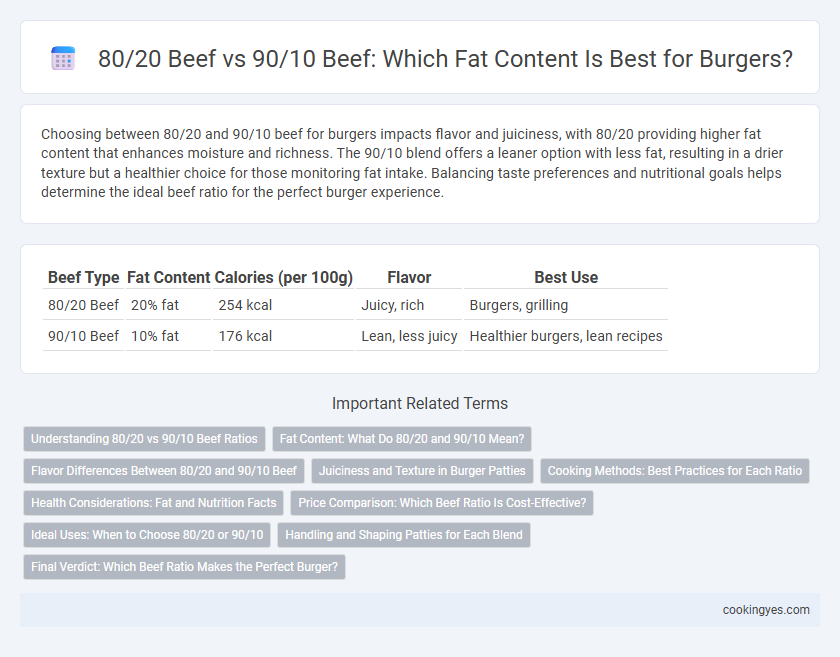Choosing between 80/20 and 90/10 beef for burgers impacts flavor and juiciness, with 80/20 providing higher fat content that enhances moisture and richness. The 90/10 blend offers a leaner option with less fat, resulting in a drier texture but a healthier choice for those monitoring fat intake. Balancing taste preferences and nutritional goals helps determine the ideal beef ratio for the perfect burger experience.
Table of Comparison
| Beef Type | Fat Content | Calories (per 100g) | Flavor | Best Use |
|---|---|---|---|---|
| 80/20 Beef | 20% fat | 254 kcal | Juicy, rich | Burgers, grilling |
| 90/10 Beef | 10% fat | 176 kcal | Lean, less juicy | Healthier burgers, lean recipes |
Understanding 80/20 vs 90/10 Beef Ratios
Choosing between 80/20 and 90/10 beef ratios significantly impacts burger juiciness and flavor, with 80/20 containing 20% fat providing richer taste and moisture, while 90/10 with 10% fat results in leaner, drier patties with less shrinkage. The higher fat content in 80/20 beef melts during cooking, enhancing tenderness and mouthfeel, making it ideal for classic burgers that prioritize succulence. In contrast, 90/10 beef suits health-conscious consumers seeking lower fat intake, though the tradeoff is a firmer texture and less pronounced beef flavor.
Fat Content: What Do 80/20 and 90/10 Mean?
The term 80/20 beef refers to ground beef containing 80% lean meat and 20% fat, while 90/10 beef contains 90% lean meat and 10% fat. The higher fat content in 80/20 burgers results in juicier, more flavorful patties that are ideal for grilling, whereas 90/10 offers a leaner option with less grease but can be drier when cooked. Choosing between 80/20 and 90/10 ground beef depends on desired flavor intensity and fat tolerance in burger preparation.
Flavor Differences Between 80/20 and 90/10 Beef
80/20 beef, containing 20% fat, delivers a richer, juicier flavor profile due to higher fat content that enhances mouthfeel and caramelization during cooking. In contrast, 90/10 beef offers a leaner taste with less fat, producing a drier texture and a subtler beef flavor, preferred for health-conscious consumers. The fat ratio directly influences burger flavor intensity, juiciness, and overall eating experience, making 80/20 the favored choice for traditional, flavorful burgers.
Juiciness and Texture in Burger Patties
An 80/20 beef ratio, containing 20% fat, creates juicier and more tender burger patties with rich flavor due to higher fat content melting during cooking. The 90/10 beef, with only 10% fat, produces leaner patties that are drier and firmer but offer a healthier option with less grease. Choosing 80/20 beef enhances juiciness and a soft texture, essential for classic burger satisfaction.
Cooking Methods: Best Practices for Each Ratio
For 80/20 beef, which contains 20% fat, grilling or pan-searing at high heat preserves juiciness and enhances flavor without drying out the patty. In contrast, 90/10 beef has 10% fat and requires lower cooking temperatures or shorter cook times to prevent toughness and maintain moisture. Using gentle cooking methods like baking or broiling suits leaner beef, optimizing texture and taste while avoiding overcooking.
Health Considerations: Fat and Nutrition Facts
80/20 beef contains 20% fat, offering juicier burgers but higher saturated fat, which can impact heart health negatively if consumed excessively. 90/10 beef has only 10% fat, providing a leaner, lower-calorie option that supports weight management and reduces cholesterol intake. Choosing between these depends on balancing flavor preferences with dietary goals related to fat consumption and cardiovascular health.
Price Comparison: Which Beef Ratio Is Cost-Effective?
Choosing between 80/20 and 90/10 beef for burgers significantly impacts cost and flavor, with 80/20 beef offering higher fat content at a lower price per pound compared to the leaner 90/10 option. The 80/20 ratio, containing 20% fat, typically ensures juicier burgers and better value for budget-conscious buyers, while 90/10 beef's reduced fat content results in a higher cost but leaner patties. For cost-effectiveness, 80/20 beef provides more flavor and moisture per dollar spent, making it the preferred choice for many consumers prioritizing price and taste balance.
Ideal Uses: When to Choose 80/20 or 90/10
80/20 beef, containing 20% fat, is ideal for juicy burgers with rich flavor and moisture, perfect for grilling or frying where fat renders and enhances taste. 90/10 beef, with 10% fat, suits leaner recipes like turkey burgers or dishes requiring less grease, providing a healthier option but less juiciness. Choose 80/20 for indulgent, classic burgers and 90/10 for lower-fat meals that still maintain beef flavor.
Handling and Shaping Patties for Each Blend
When handling 80/20 beef, the higher fat content requires gentle shaping to prevent excessive fat loss and maintain juiciness, making minimal compression essential to preserve texture. In contrast, 90/10 beef blends demand careful but firmer shaping to ensure patties hold together due to lower fat binding, often needing slight pressure to avoid crumbling during cooking. Optimal handling techniques for each blend enhance flavor retention and structural integrity, crucial for achieving a perfect burger bite.
Final Verdict: Which Beef Ratio Makes the Perfect Burger?
An 80/20 beef ratio, containing 20% fat, provides juiciness, rich flavor, and optimal moisture, making it ideal for a classic, flavorful burger with a tender bite. A 90/10 beef ratio offers leaner content, resulting in a drier, less flavorful patty that can benefit from added moisture or fat supplements. For the perfect burger that balances taste, texture, and juiciness, the 80/20 beef blend remains the preferred choice for chefs and burger enthusiasts.
80/20 beef vs 90/10 beef for fat content Infographic

 cookingyes.com
cookingyes.com